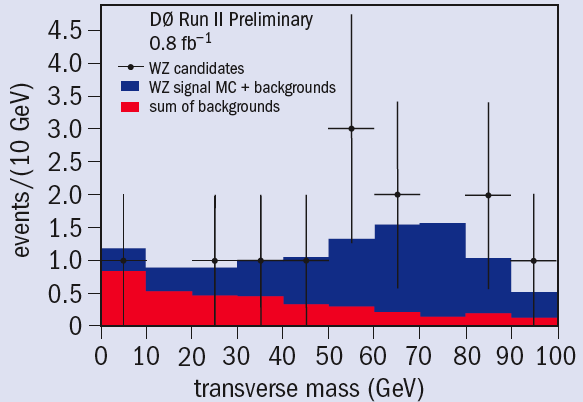The D0 Collaboration at Fermilab has announced the first measurement of the cross-section for WZ pair production in proton–antiproton collisions. The cross-section times branching ratio for the process is the smallest ever measured at a hadron collider. The data for this result were taken from more than 1 fb–1 of total collision data at the Tevatron, and a sample of 1.5 thousand million events.

Making this measurement requires events in which both the W and Z boson decay to leptons, but while such events provide the cleanest signature of WZ events, they constitute only 1.4% of all WZ decays. D0 found 12 events, each containing three charged leptons with high transverse momentum together with missing transverse energy (indicating an undetected neutrino), with an expected background of 3.6±0.2 events. The probability that the background accounts for these 12 events is 4.1 × 10–4, which constitutes 3.3 σ evidence for WZ pair production. With these events D0 measures the WZ production cross-section to be 4.0 +1.9–1.5 pb, which is consistent with the Standard Model prediction of 3.6±0.3 pb.
The coupling of the weak vector bosons is an important consequence of the non-Abelian nature of the Standard Model, and the rate for the associated production of W and Z bosons in proton–antiproton collisions allows this coupling to be probed. The kinematics of the Z boson decay can also be used to characterize the interaction between the W and Z and provide further constraints on the nature of the electroweak force. In addition, measuring the cross-section times branching ratio for Standard Model processes with such low rates is an important stepping stone in the search for the Higgs boson at the Tevatron.
Further reading
The preliminary D0 result is described at http://www-d0.fnal.gov/Run2Physics/WWW/results/prelim/EW/E15/E15.pdf








